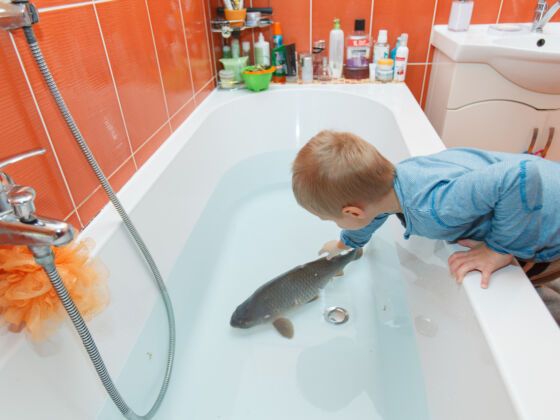In many American households across the country, the holiday season requires a dose of chaos. There is much hustling and bustling between the grocery store and the kitchen, prepping, stirring, roasting, and whipping together meals for loved ones. Much of this cooking will involve handling fish and fowl for those meat-eaters among us, but for the most part, the animal is blessedly already dead — needing only to be brined or baked before serving. For some people in parts of Eastern Europe, however, that is certainly not the case, and dinner is very much alive when it arrives in the kitchen a few days before Christmas Eve dinner.

Why Some Polish Families Keep a Live Carp in the Tub Before Christmas
For many years, custom in Poland and its neighboring countries dictated that families head to their local fish market and buy a live carp for the holiday season. Instead of butchering it right away, they fill up the tub and keep it alive for the next two or three days. At the end of its tenure as a resident of the bathroom, the carp becomes the main course at the elaborate 12-course feast (one dish for each of the 12 apostles) known as Wigilia.
You can thank the Roman Catholic church for this fishy custom: Christmas Eve was traditionally considered a day of fasting, and devotees were not permitted to eat meat. Seafood, however, was entirely permissible, and over the years, Christmas Eve dinners evolved to include fish as the main course. Carp is the most popular choice in Eastern European countries like Slovakia, Poland, and the Czech Republic, as well as Germany and Croatia. For the latter two countries, the fish is thought to bring such good luck and prosperity that the scales are sometimes tucked under dinner plates and carried around in wallets to attract wealth.
According to NPR, the carp in the bathtub tradition is likely rooted in a time of pre-refrigerator necessity, and the practice was a way to keep the carp fresh before it was time to cook it. It might also be a method for clearing mud from the carp’s digestive track before cooking, but NPR spoke with a scientist who says it would probably take much longer than three days to be effective.
“The Christmas Eve carp swimming in the bathtub still happens today, although it was much more common decades ago when families would not have had a refrigerator in the kitchen,” confirms Lois Britton, an American expat who has lived in Poland for about a decade, and the author of The Polish Housewife recipe blog and cookbook. “There are a couple of reasons for the bathroom aquarium. Carp often has a muddy taste, so a few days in clean water without food is supposed to cleanse the fish and improve the flavor. They seem to do well with tap water [but] my friend, Grzegorz, tells me they occasionally had a runaway — carp would jump out of the tub and have to be returned. His parents added a bit of salt to the water and when the fish started to swim sideways, it was time.”
Once Christmas Eve arrives, the carp’s time in the bathtub is up. Then, it’s all up to the family to kill, butcher, and cook — which can sometimes prove challenging. Karolina Cala, a digital marketer based in Manchester, says her Polish family has never partaken of the tradition, but her mother recalls keeping carp as a temporary pet before Christmas Eve in her childhood — and skipping showers because the carp took precedence over hygiene for those few days it lived with the family.
“My mum has told me of what it used to be like when she was younger,” Cala tells me. “The carp lived in the bathtub for a few days, and then grandpa would smack it with a hammer on Christmas Eve. Once, the carp managed to jump out of the tub and kill itself. They still cooked and ate it.”
The Independent reports that in places like the UK, where there is a large population of Polish immigrants, the tradition is going out of style, mostly because some grocers have stopped selling live carp. However, it’s recently become less popular in Poland, too: Cala confirms that supermarkets have also begun to ban the sale of live carp.
“Up until as recent as last year, you could stroll into carrefour and there would be an enormous pool with live carps inside,” Cala says. “I have some quite vivid childhood memories of seeing fish being carried by shoppers in water-filled plastic bags.”
This Christmas tradition hasn’t faded completely into legend though. Zuza Zak, author of the cookbook Polska, thinks that bringing home the live carp is mostly confined to more rural areas of the country these days, “as more comfort orientated city folk are more reluctant to give up their bathtubs.” Like Cala, Zak’s mother recalls (not entirely fondly) giving up bath time because the carp occupied the bathroom.
“A fresh carp was clearly the priority because everyone put up with this discomfort,” Zak tells me.
Zak and her family moved to England when she was eight and stopped carrying on the Christmas carp tradition — partially because it was difficult to get fresh carp and partially because no one liked the fish anyway. Today, Zak serves several varieties of herring at her Wigilia feast instead.
Considered a bringer of prosperity, luck, and wealth, it might not be a stretch to say that in many countries throughout Eastern Europe the carp is a beloved companion to the Christmas season. Carps might not swim in many bathtubs anymore, but if you’re still nearly guaranteed to see one at the dinner table at the very least — and if you do, you might snag one of its scales to keep in your back pocket. You never know what blessings the carp might bring in the new year.